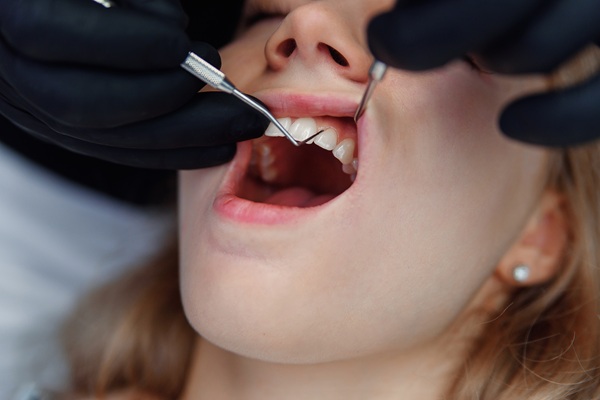Gum Disease Treatment Options from a Family Dentist

Gum disease treatment is an important part of comprehensive oral healthcare. A family dentist can address gum issues when they first appear, which can preserve your smile and improve your overall oral health. These dental professionals offer a variety of gum disease treatment options based on the stage and severity of the condition.
Gum disease 101
Gum disease, medically known as periodontal disease, is an inflammatory condition that affects the gum tissues and supporting structures of the teeth. It typically begins as gingivitis, characterized by red, swollen gums that may bleed when a patient is brushing or flossing. Without proper care, it can progress to periodontitis, where deeper infection and bone loss may occur. In severe cases, advanced periodontal disease can lead to loose teeth and tooth loss.
Common risk factors of gum disease include:
- Poor oral hygiene
- Stress
- A family history of gum disease
- Chronic health conditions (e.g., diabetes and cardiovascular disease)
- Certain medications (e.g., immunosuppressants, antidepressants, and antihistamines)
- Smoking or using other tobacco products
Fortunately, regular dental visits allow the dentist to detect the earliest signs of gum disease and recommend the appropriate treatment option.
Non-surgical treatment options
In the early stages, gum disease treatment will typically involve non-surgical methods that aim to control the infection and restore the patient's gum health.
Professional dental cleaning
Routine cleanings, typically performed every six months, remove plaque and tartar buildup from the teeth and along and under the gum line. While this treatment option is not a cure for gum disease, regular cleanings can help prevent the condition from progressing. Patients with a history of gum disease may require more frequent cleanings than the standard twice-a-year schedule. Instead, the family dentist may recommend them every three months.
Scaling and root planing
For patients with mild to moderate gum disease, a deep dental cleaning, also known as scaling and root planing, removes plaque and tartar from below the gum line. Then, the dentist smooths the tooth roots to encourage the tissue to heal and reattach to the gums. While more invasive than a traditional dental cleaning, the dentist will typically administer local anesthesia to ensure the patient remains comfortable during the treatment process. The patient will also need to attend regular follow-up visits to monitor their healing process and assess the need for further treatment.
Antibacterial and medicinal therapies
In order to improve the effectiveness of traditional and deep dental cleanings, the family dentist may recommend specific antibacterial treatments or medications. These could include prescription mouth rinses containing chlorhexidine, which help reduce bacteria and plaque buildup. They may also prescribe antibiotics to address more advanced oral infections.
Antibiotic therapy
In some cases, the dentist may use localized antibiotic gels, microspheres, or oral antibiotics to treat persistent gum infections. These medications target specific strains of bacteria. The dentist may place it directly into periodontal pockets for extended release.
Surgical treatment options
In advanced stages of periodontitis, the family dentist may recommend surgical intervention to stop the disease from progressing and restore the patient's long-term oral health. Depending on their skills and expertise, the dentist may refer patients to a periodontist for these procedures.
- Flap surgery (pocket reduction surgery): This procedure lifts the gums to remove deep tartar and reduce periodontal pockets. The gum tissue is then secured back in place for better hygiene and lower reinfection risk.
- Bone grafting. Bone loss from advanced periodontitis can be treated with bone grafting. This process involves the dentist placing bone or synthetic materials in affected areas of weakened tissue and improving the stability of the tooth.
- Soft tissue grafts. Soft tissue grafts can help treat gum recession by covering exposed roots and reinforcing the gum line. The dental professional will often source the tissue from the roof of the mouth or a donor source for this procedure.
Maintenance and ongoing care
Effective gum disease treatment does not end with initial procedures. Long-term success relies heavily on maintenance care provided by a family dentist. For example, patients with a history of gum disease will typically need to undergo periodontal maintenance visits every three to four months for cleanings and monitoring.
Additionally, the dentist will take the time to educate patients about proper brushing and flossing techniques. They may recommend products like interdental brushes and water flossers to make it easier for them to clean their teeth in between dental appointments. Patients should take the steps to limit their consumption of tobacco products, if not quitting, to reduce the risk of the gum disease from progressing or worsening.
Learn more about Miami Implant & Family Dentists's gum disease treatment options
By taking proactive steps and partnering with a trusted family dentist, you can preserve your gums and feel confident in a healthier smile. Would you like to learn more about Miami Implant & Family Dentists's gum disease treatment options? Call our Miami office to talk to our team or to schedule an appointment.
Request an appointment here: https://implantfamilydentist.com or call Miami Implant & Family Dentists at (305) 230-4040 for an appointment in our Miami office.
Check out what others are saying about our dental services on Yelp: Gum Disease Treatment in Miami, FL.
Recent Posts
Gum disease starts with the growth of bacteria in the mouth. When brushing or flossing does not remove this bacteria, harmful plaque accumulates and hardens into tartar. The collection of tartar along the gum line results in gingivitis, which can worsen into periodontal disease. Symptoms of this disease can be mild in the early stages,…
Gum disease is a bacterial infection that causes inflammation in the gums and bone surrounding the teeth. The resulting inflammation causes bone loss and eventually, tooth loss, and it can contribute to other health problems. Once a patient has been diagnosed with gum disease (periodontal disease), prompt treatment is necessary to address the condition. Most…
Gum disease is a common dental problem. Poor oral care, lifestyle, and diet contribute to the onset and worsening of this condition. Preventing periodontal disease is better than going through the treatments. If you want to know why preventing gum disease is important, here are the details.Preventing gum disease can keep teeth looking good and…
Gum disease is often hard to avoid; however, once it is detected, patients can immediately visit their general dentist for a diagnosis and treatment plan. In order for it to be detected, the dentist will have to rely on any symptoms or signs that indicate a problem. Ready to learn more about the signs?Sometimes when…


